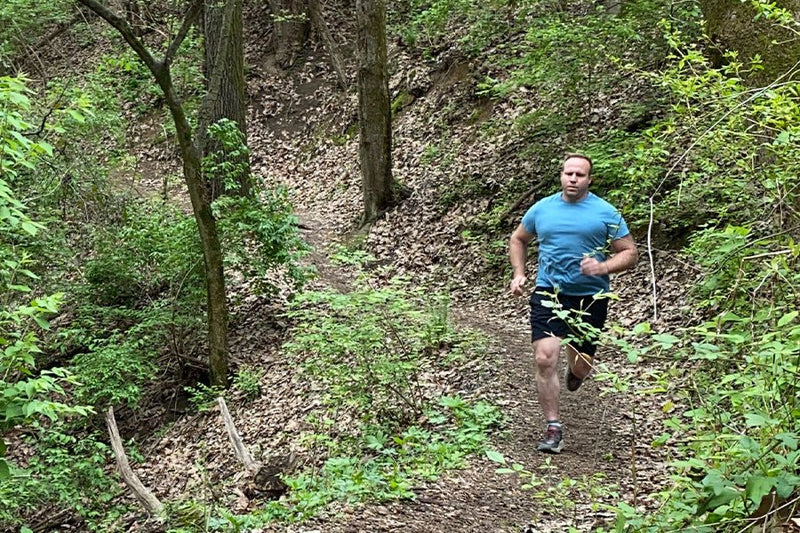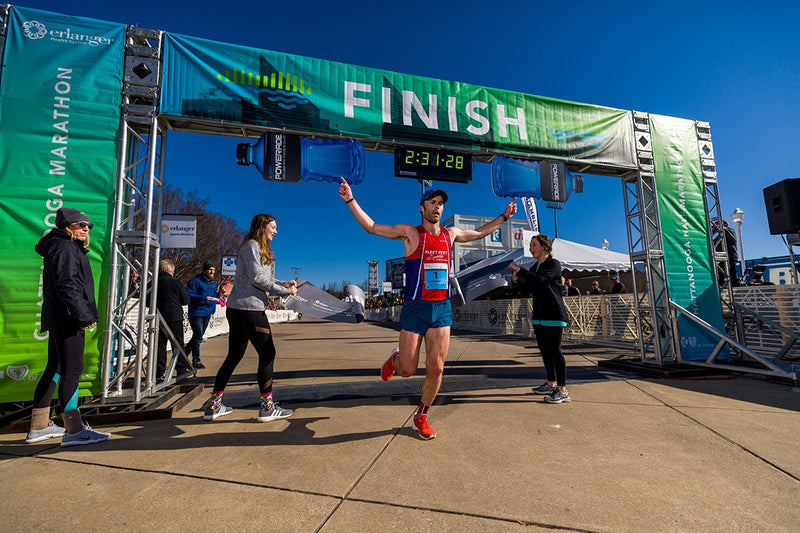
By Christopher Newgent
It happens every year around this time. I resurrect my Couch to 5K app, lace up my running shoes, and head to the nearest trailhead. There are seasons of my life where I’ve gotten a wild hair about running, but I’ve never really stuck to it long enough to consider myself “experienced” or “a runner.” And when I moved to Chattanooga a few years ago, I discovered trail running.
I love trail running. It reminds me of being a kid, running around the woods behind my house playing Peter Pan or Knights & Monsters or whatever other make believe I came up with that day.
Plus, it keeps my mind occupied in a way that road running doesn’t. My friend Ginny once said, “When I’m trail running, every step is a decision,” and I’ve not found a better way to describe it. A root there, a rock there. Even on smoother sections of trail, you have the woods to lose yourself in.
Even still, I’ve not managed to crack Week 8 on Couch to 5K. My life (or another hobby) always ends up breaking the routine, and I start all over again 6 months later. I still very much feel like a beginner, so I thought I’d share a few things I’ve learned in all the times I’ve set out to become “a trailrunner.”
Maybe hearing from another beginner is just the thing you need to begin trail running yourself! Here we go!
What Gear Do You Need to Start Trail Running?
Possibly the most asked question by anyone starting out, so I'll start here. Lots of articles and photos of trail runners make you think you need all the things: trail shoes, tech clothing, hydration vests, GPS tracker, a Strava account, etc., etc.
To Start: Get a Good Pair of Trail Running Shoes
The truth is—all you really need to start is comfy athletic clothes and a decent pair of trail running shoes. I personally run in HOKA Speedgoats. I find they support my stride well and the cloud-like soles make it a little easier on my joints as I get started. Entire articles or series of articles can be written on which shoes are the best and why, but ultimately to start out, get shoes that are comfortable for you and support the way your feet hit the ground.
It’s pretty standard these days for running stores to have staff trained in watching your stride so they can recommend shoes based on your specific needs. Some of them even have a treadmill with a camera set up to record how your feet hit the ground. If you can, I highly recommend doing this. A good pair of shoes can make or break your running routine.
To Start: Safety Gear on the Trail
This all depends on where your trails take you. I personally run on well-trafficked and maintained trails around Chattanooga, so I don’t generally worry about safety items. My safety kit includes a trail whistle and a headlamp if sunset is looming (especially in the winter).
Different regions might require additional items like bear spray, tick repellent, and so on. If you’re interested in trail running, likely you’re already somewhat outdoorsy and aware of your regional nuisances. If not, I recommend contacting a local outfitter or outdoor shop to ask what you might want to be wary of in your neck of the woods.
Eventually: Treat Your Feet to Good Merino Wool Running Socks
Here’s the one Sockwell plug I’ll make. My boss might get mad at me for saying you don’t actually need our socks to start trail running (and honestly, you don’t need them even if you’ve been trail running for years).
But!—I will say, a nice pair of merino wool compression socks feel AMAZING when I’m trail running.
I never knew how game-changing merino wool socks are until I started working at Sockwell. But hoo-boy. Merino wool helps manage sweat and temperature like nothing else—summer or winter. And the compression fit in our socks doesn’t just help with blood flow and support my muscles and tendons, it also keeps my socks firmly in place. All of that combined means blister-free socks on top of all the other benefits.
So which Sockwell socks do I recommend, you ask? For the summer, I love our Run/Fitness Sport Compression socks. I find the merino wool/bamboo rayon blend is more summer friendly. And our Hike/Outdoor compression socks are amazing for running in colder weather; the extra cushioning and the wool/alpaca blend adds a touch more warmth.
A couple notes on socks:
- I recommend getting at least quarter-length to help protect your ankles a bit and when I’ve worn micro-length socks, dirt always seems to weedle its way into the tops of my socks.
- Also, when I’m first starting out, I wear our Plantar Fasciitis Relief socks during my run, and for recovery the day after. Truth be told, I’ve gained some COVID weight, and having the extra support for my plantar and Achilles helps prevent plantar fasciitis flareups in the early weeks of restarting my running routine.
Eventually: Get Some Sort of Hydration Pack
I sweat…a lot. And we all know hydration is important. But until about week 8 of my Ct5K app, I honestly don’t find myself needing anything more than a bottle of water waiting for me at the trailhead. Once I start getting into the 8-10 minute jogging intervals, I start noticing a thirst on the trail. If it’s warmer out (especially mid-summer), then I start noticing it around Week 6 (6-8 minute jogging intervals).
Of course, everyone’s hydration needs are different. Once you get into longer runs or warmer weather, it’ll be nice to have some sort of Camelbak or running hydration vest/belt. But you definitely don’t need one to start.
Totally Optional: All the Other Stuff
Just like every hobby out there, there are all sorts of bells and whistles you can get for running. Smart watches and heart monitors and GPS trackers. Technical athletic clothing and expensive cold weather layers. Strava subscriptions and running apps. If you can afford them and you find them helpful, dive in.
If I were to provide advice here, I’d say the athletic clothing and cold weather layers are the best bang for your buck. I spent the few dollars to purchase a Ct5K app because it just automates all the scheduling and interval timers and makes it incredibly easy to get started according to the Ct5K plan.
Just know, you don’t need these things to run.
Focus on Improving Your Gait

This is my #1 tip as far as actual running advice. I cannot tell you how much better my running life became when my stride finally clicked for me. It takes a bit for your body to figure it out. And even once the form clicked for me, it took 2-3 weeks for me to build up the fitness to actually be able to run this way for my entire workout.
This is all about how your feet first hit the ground as you’re running. I'm not a physical therapist or a body mechanics expert, so I'll defer to them regarding this.
"To run with proper form, you should focus on landing your feet as close to under your hips as possible. This will help to reduce the braking forces that your body experiences with each stride. Keep your running cadence high to achieve this, and aim to run with a midfoot strike.
In fact, where your foot lands on the ground (relative to your centre of mass), is so much more critical to your running efficiency, than the type of foot strike you choose to run with. If you heel strike, feel free to continue doing so, just work on making it a more “gentle” heel strike by increasing your running cadence and bringing your landing foot closer to under your body." (Kinetic Revolution)
I found for me, running a little more forward helps keep my knees happy and once I built up some strength and better flexibility in my ankles and Achilles, it just felt...great.
It did feel very springy and bouncy at first, and to be honest, you may feel kind of silly if you try doing this yourself. I know I did. Since my pace was so slow, I felt like I was running more up-and-down than forward. When faster runners use this form, it looks graceful like a deer or gazelle—but I felt more like I was a fishing bobber, bouncing up and down but barely moving.
But stick with it. Find the stride that works best for you. Trust me. Your joints will thank you. (And so will your PT.)
Should You Do Couch to 5K?
I’ve mentioned it a few times already in this article, so you might already know my answer. For beginners, I really recommend Couch to 5K. And combined with the Ct5K app I got, it just makes getting into running…easier.
In case you’re unfamiliar, Couch to 5K is a training schedule that slowly builds up run-walk intervals over the course of several weeks until you finally end up running an entire 5K in one go. Every workout starts with a 5-minute warm up walk, then goes through a series of intervals, before finishing with a 5-minute cool down walk.
The first week starts you out with 1 minute of jogging and 1.5 minutes of walking—you do that 8 times, and voila. You’ve done your first 20-minute run-walk. The next week, it’s 1.5 minutes of jogging with 2 minute walks in between. And so on.
I’ve found it to be a really incredible way to get into running without overdoing right out the gate. Combined with my Ct5K app, it takes all the logistics out of getting started. I just drive to the trailhead and click Go. It tells me when to run and when to walk, increasing the intervals according to the schedule, and it even adjusts them based on how difficult a run might have been for me.
That said, I have learned one downside to using Couch to 5K, which brings me to my final bit of advice.
Learn to Settle In and Enjoy the Run
If there is one gripe I have about Couch to 5K, it’s that you don’t get to experience “jogging” until around week 7-8. It’s around this time that your run-intervals get long enough that you have time to settle in and just…run. Up to this point, I was very conscious of the timer and how often I thought, “How…how much longer…until…until I get to walk again…”
But once the intervals get into 6 minutes, then 8 minutes, then 10 minutes, and so on—that’s when the real magic happens.
That’s when I stop thinking about the timer so much. Maybe I check it once or twice, but overall, I’m just…jogging. I’m listening to my tunes and noticing the trees are beginning to bud and—oh, watch out for that root real quick—look, some small yellow flowers have popped up in that bank of moss and the birds are chirping and squirrels chattering at each other and—DING “Slow down and walk.” And I've just jogged for 8 minutes.
To be honest, in the couple weeks it’s taken me to write this article, I’ve fallen out of my routine again. Ironic, I suppose, that in the time I’ve been thinking more about trailrunning, I’ve stopped actually running.
But that’s also part of settling in. It’s okay to miss a run sometimes.
It’s good to have a routine, but try not to hold yourself to rigid standards and schedules. For me, that often leads to feeling like I failed if I miss a run. And feeling like a failure just sucks the joy out of running and keeps me from the trail.
If (or when) that happens, just remember why you’re out there in the first place. You’re not out there for Couch to 5K’s sake. Maybe you've registered for a 5K and you're working towards that, but really, that's not why you're out there.
You’re out there for yourself. Maybe it’s to improve your health. Maybe it’s to enjoy nature. Maybe it’s to run off some stress or jog with a friend. Maybe it’s all these things and more. You're out there for you.
Lace up your shoes. Let’s go.






